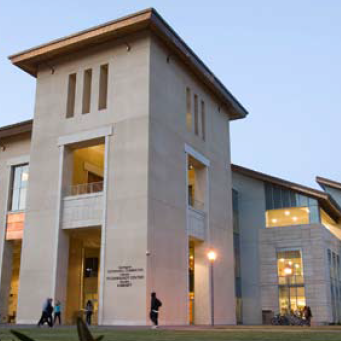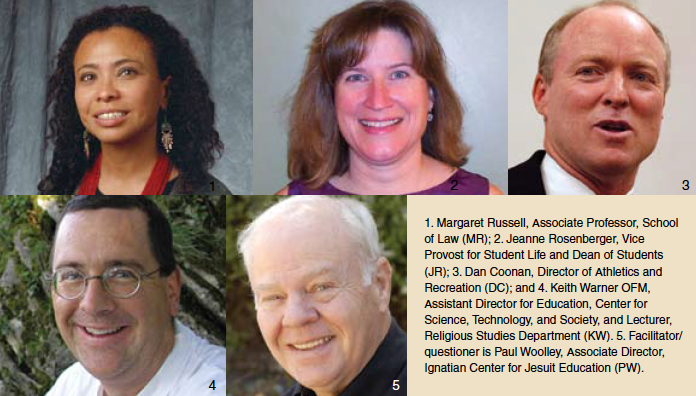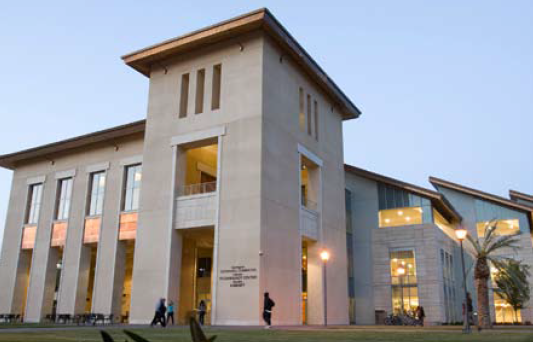
Exploring the Decrees of the Jesuit General Congregation 35
A Roundtable Discussion with Santa Clara University Faculty and Staff
Editor’s Note: For reference in this discussion, readers may want to review the summaries of the decrees, found on page 7. This is a condensed version of the edited roundtable transcript.
Participants: Margaret Russell, Associate Professor, School of Law (MR); Jeanne Rosenberger, Vice Provost for Student Life and Dean of Students (JR); Dan Coonan, Director of Athletics and Recreation (DC); and Keith Warner OFM, Assistant Director for Education, Center for Science, Technology, and Society, and Lecturer, Religious Studies Department (KW). Facilitator/ questioner is Paul Woolley, Associate Director, Ignatian Center for Jesuit Education (PW).
PW: Decree 2, paragraph 7, states “The commitment to the service of faith and the promotion of justice, to dialogue with cultures and religions, takes Jesuits to limit situations, limit situations where they encounter energy and new life, but also anguish and death.” What might be examples of these new limit situations in the 21st century?
DC: For us at SCU, our many student immersion trips come to mind as a powerful example of “limit situations.”
MR: At the law school, we expose students to these “limit situations,” to people who are mistreated, wrongfully incarcerated. And our students work with juveniles who are in trouble and need to get a sense of what their rights are. However, I think we could be clearer and more honest with our students about what lessons can be had from these limit situations. We need to go deeper, in terms of the spiritual and the divine that students might encounter.

JR: I remember talking with a resident minister about a student who had mental health issues. The sense from the other students was “Can’t they go somewhere else? I do not want to encounter them in the hallway because it makes me uncomfortable.” But we helped those students see that we have to find a way to embrace this person in our community. It was an important conversation, and they were clearly uncomfortable. This was a “limit situation.”
KW: The challenge is to grow in compassion and to grow in terms of being able to respond and convey that vision of radical inclusion in the community.
JR: The “other” is an important part of the immersion experience. It is not just going to Mexico or building a house or going to a clinic. The question is: How do you prepare yourself to have that encounter with the other?
DC: In athletics, almost all of our teams do some kind of immersion, whether it is with a food bank or a homeless shelter or other groups. I do exit interviews with our athletes, and almost every one of them has a sense of wanting to do better for the world and for each other.
PW: Decree 2, paragraph 20 states: “Globalization, technology, and environmental concerns have challenged our traditional boundaries and have enhanced our awareness that we bear a common responsibility for the welfare of the entire world and its development in a sustainable and living way.” In this context, how would you describe the new frontiers that face higher education in developing our contemporary world in a sustainable and lifegiving way?
KW: We must help students, faculty, and staff recognize that all of these challenges have serious moral and spiritual implications—globalization, technology, and environmental concerns.
MR: I have really been puzzling over this subject given that I am very interested in the whole political debate about global warming and theological beliefs and the inevitability of what happens to the earth versus the human responsibility to do something. But I am shocked to realize that people take those two words, moral and spiritual, in very different ways. And so how do we have that conversation with our students without making the focus politics? How do we make the focus ethics and spirituality?

KW: I do not think “political” is the question. I say it has become partisan. And the problem is that in this country it breaks down along partisan lines. The environmental degradation and the negative effects of economic globalization have very severe consequences for the social fabric of society. We have to look at that and the fact that our actions are driving it, especially those of us in the U.S. We need a moral framework that helps us recognize our responsibility and duty to a natural world in the future generations.
PW: But what do we actually do as a university in terms of our responsibilities to educate young people and ourselves as well? How do we make a contribution to the world in which we live, in terms of the accumulation of knowledge? What kind of courses would be taught? What would our syllabi look like?
MR: Take for example, a course in environmental law, which might not focus on the moral issue that you pose or any notion of the sacred. It might discuss political interest groups, property interests. One of the new frontiers that faces us is to try to figure out a way to articulate some common ground ethically in a way that does not lose people who think that what we are doing is dictating a partisan position.
KW: That is a cross-cutting issue in our professional programs. How to insert questions about ethics into the professional degree programs is not a trivial question. It is a real one and I think the three realities that are identified in decree 3 are pushing it along faster. How do we respond to globalization from a moral perspective? How do we think about technology and its relationship with our belief in the dignity of human person? How do we think about environmental concerns from the perspective of impacts on the social fabric of communities?
PW: In terms of the buildings on our campus, there is a great sensitivity toward sustainability. The Learning Commons recycled most of the materials from the old library building as it was torn down. The new building is actually consuming no more energy than the original library while it is twice the size.
KW: Just look at the importance of sustainability in the engineering school. They are doing terrific things to incorporate sustainability across the curriculum of engineers so every student will encounter questions of sustainability and their relevance to engineering.
JR: Our Center for Science, Technology, and Society (CSTS) collaborates with the San Jose Tech Museum in presenting the annual Tech Awards for projects that benefit humanity. SCU has elected to identify, celebrate, highlight, and support those that are using technology for the benefit of humanity.
PW: Decree 3, paragraph 23 states: “We need to walk with young people, learning from their generosity and compassion so as to help each other grow through fragility and fragmentation to joyful integration of our lives with God and with others.”
MR: I have a comment about this based on teaching graduate students who are entering a very competitive field and who are very concerned to cover over their joyfulness and their fragility. This year, for example, we had a panel during orientation that was titled “Professors are People.” And the professors thought, “Of course they know we are people.” But, they did not. And so we just answered very simple questions and showed them our humanity and vulnerability. About two weeks after that there was a very tragic and sudden death of a student in the first-year class. Thecombination of those two experiences was the first time in a long time I had realized that these students are fragile. And so when I read this part of the document, I thought, “How do we help them keep the joy in the face of academic pressure and life pressure?”
KW: I think community is essential to help with this integration process. And I think that is what draws a lot of our students here. We just need to be clearer about the fact that that is where people find healing and that is where people find the resources to do the integration, to overcome some of the fragmentation.
PW: Decree 3 notes that “We live in a culture that shows partiality to autonomy and living in the present.” We can get so caught up in “me, me, me,” and taking care of myself, and getting ahead and not building a sense of community. That is where the fragmentation can come in. Question: How do we help them build community?
JR: We are becoming more competitive in recruiting students. Our students are sitting in a classroom with many others who were also at the top of their class. This may be the first time somebody is not there to jump in and tell them they are great. It is probably different with athletes because they experience competitiveness a little differently. But many of our students have not been disappointed in their life until they get here, and that is difficult. How do we help them manage that?
DC: I see it with the athletes. Parents are more involved and there is a sense of entitlement that was not there in earlier generations. To that point, all the needs in their life have been met. When they see that first disappointment, whatever form it takes, it can be tough.
KW: Disappointment is an essential learning experience. Can we be there to create a sense of community that can help them hold that experience so they do not try to deny or run away from it? And can we support each other as faculty and staff in making ourselves available to mentor students? Because often, even those bitter experiences for the students are often the best experiences, in terms of their ongoing transformation.
PW: When you read student reflections on their immersion experiences, that is one of the common themes that come out. They recognize that they have been privileged. And they also see people who live in abject poverty who have such a deep faith and sense of community and joy.
DC: In terms of what we can do in athletics, we have an advantage. We have coaches whose message is “How you handle this adversity will define you as a person.” And when a student hears that idea, they start to get it.
JR: We recognize that the developmental level of 18-year-olds today is different from what it was 15 to 20 years ago. I was thinking about commencement day. While it is a very joyful day, I see how frightened and terrified some students are. To leave this safe community of supportive mentors and friends where I have learned to be myself, figured out who I was—this is a challenge to a joyful integration. Can I go and make a life for myself outside of an environment that I felt very safe and protected in?
KW: Being able to make a good decision based on self-knowledge is an even more pressing need in our culture now than it was 20 years ago. We need to help students know who they are, know what gives them joy, and know how they might be able to make a positive impact on the world with their gifts. Those are really essential gifts that we can help our students grow in. And that, to me, is the exercise of a moral agency, being able to make good choices.
JR: And if you make a bad choice, to be mature enough to deal with the consequences of your choice. There is learning and growth in that as well, as opposed to having someone else come in and be your referee or your savior.
PW: Decree 3, paragraph 35 states: “We should find ways in which our experiences with refugees and the displaced on one hand, and people who work for the protection of the environment on the other hand, could interact with those institutions so that research results and advocacy have effective political benefits for society and the environment.” Question: This article seems to call for interdisciplinary efforts between research and advocacy. What might be the nature of this kind of research and advocacy? And who might the interdisciplinary collaborators be?
KW: I will talk about this as a faculty member. This suggests that there would be incentives for faculty to do research that addresses the mission of the university. We could consider networking the centers of distinction with our faculty and their research that would have some potential for practical application towards questions of social justice, community development, sustainable development, and environmental protection.
MR: And including students in the research would be a great way to mentor and model for them.
DC: One good model is Florida State’s Human Rights Institute which they started six years ago. They deal with issues of human trafficking and torture, and they are viewed as experts now. They grant undergraduate and graduate degrees in human rights and they get faculty from many different disciplines, e.g. law, criminal justice, and sociology. Through their program, they get students placed all over the world.
PW: Decree 6 on “Collaboration at the Heart of the Mission” reflects with gratitude on how the Society has responded to General Congregation 34, the preceding Congregation’s call to cooperation with the laity in mission. Question: If we are lay collaborators at Santa Clara University, a Jesuit university, how do the Jesuits share this mission with the lay collaborators?
PW: One way is through the Ignatian Faculty Forum, which consists of monthly four-hour meetings throughout the academic year. The sessions are designed to explore and demystify the Jesuit ethos. In it, participants read about and explore Ignatian spirituality in the context of their own development as teachers/scholars. We also have Staff Luncheon Reflection sessions. In six sessions, once a month, we do readings and meet to discuss them, and it is meant to help staff explore what it means to work at a Jesuit university. How do we get connected within Ignatian tradition?
JR: I think there would be a tremendous response to offering more of the Ignatian Spiritual Exercises in some form. There are not a lot of sustained opportunities. Paul Locatelli kept a blog when he was at the General Congregation. Once the word got out that he was keeping this blog about what it was like every day and what he was experiencing, there was so much interest and curiosity about what the Jesuits were doing.
DC: I think that for both students and staff, there is a lot of interest in the Jesuit values and in the community service and social justice elements of the University’s mission.
KW: One issue is that our campus is multireligious. A lot of the things that are spoken about in a Jesuit school may not even apply here because the majority of our students do not necessarily come from Catholic backgrounds.
JR: There is more we could be doing to help new faculty and staff integrate. And the whole notion of being lay partners and collaboration is critical here at SCU, because there are not that many Jesuits left. I think they are reaffirming in this decree the need to sustain a lay partnership.
PW: People’s point of entry into the Ignatian tradition is different. Some people who tend to be of a social justice bent tend to enter into the Catholic and Jesuit mission through justice and service and then once they get there they realize there are deeper spiritual values. Some people enter into the tradition through their faith life. Their interest is spiritual, but then when you start teaching them about a spirituality that calls them to action, they see the social justice dimension to the tradition.